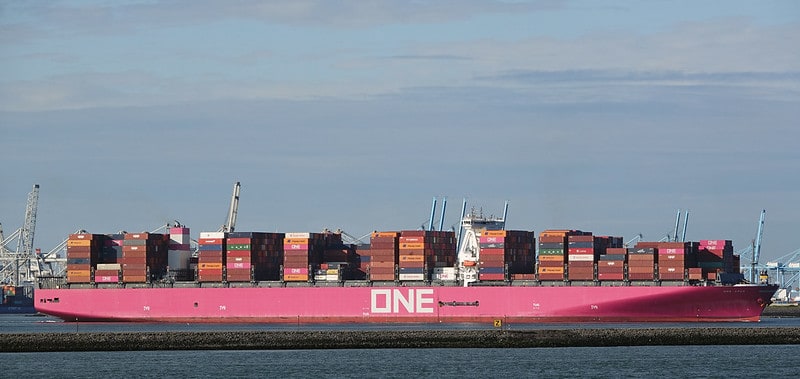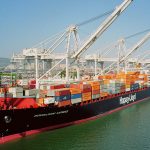You Won’t Believe How Many Shipping Containers Were Lost to the Pacific Ocean Last Winter
This is staggering. Over 3,000 shipping containers fell into the Pacific Ocean last winter, Tim Lydon reports in the Revelator. We’re not talking about all shipping containers lost throughout the world over the full course of 2020. We’re just talking about shipping containers that fell off transpacific containerships from Asia to the U.S during the winter of 2020.

After a few paragraphs about the megaship ONE Apus’s massive loss of containers when it was hit by a storm on its way from China to Los Angeles, Lydon writes:
It was also only one of at least six spills since October that dumped more than 3,000 cargo containers into the Pacific Ocean along shipping routes between Asia and the United States. They include the loss of 100 containers from the ONE Aquila on Oct. 30 and 750 containers from the Maersk Essen on Jan. 16. Both ships encountered rough weather while delivering goods to the United States.
Various Dangers to Cargo at Sea
Cargo faces many dangers at sea.
We posted a couple blogs about the ONE Apus back in December of last year. In the last blog about it, we shared WK Webster & Company’s drone footage that had been posted on Youtube, showing massive shipping container stacks that had fallen over on the ship. It’s obvious that many containers from those toppled stacks are missing altogether. In case you missed it, here’s the video:
I’m pretty sure neither the Maersk Essen nor the ONE Aquila made Universal Cargo’s blog (before now). It’s not uncommon for us to blog about major accidents with containerships, as the loss of cargo (and sometimes worse – the loss of life) has an obvious impact on shippers. However, it would be impossible, only publishing two blogs a week (usually), for us to cover every containership accident, hijacking, or loss that happens throughout the year while still keeping shippers informed on the most important news stories in international shipping.
Sometimes, these accidents are the biggest news stories impacting shippers’ importing and exporting. After all, it was just a couple months ago Evergreen’s megaship the Ever Given turned sideways and ran aground in the Suez Canal. There was worry the canal could be blocked for weeks. Luckily, workers were able to get the ship free within about a week. Still, congestion rippled from the Suez Canal to ports around the world at a time when port congestion was already a major problem in many places, but especially at U.S. ports. Shippers are still dealing with and paying for the fallout of the Ever Given damming the Suez Canal. That was such a big story, mainstream media picked it up and Lydon even made mention of the Ever Given incident at the top of his Revelator article despite the fact that it in no way contributed to the 3,000 plus shipping containers that ended up in the Pacific Ocean last winter, which is what his article was about.
A few years ago, there had been such an uptick in fires on containerships, we had to do a blog harping on the need for better container content verification in the international shipping industry. One of the problems causing fires on the ships was undeclared or misdeclared hazardous materials. Not only has this problem put the cargo of other shippers at risk, but it has also cost sailors their lives.
Luckily, no seamen lost their lives when ONE Apus lost all those containers in a storm. Unfortunately, crews of ships are not always so lucky. In 2015, we blogged about the El Faro, a cargo ship that was lost during Hurricane Joaquin, only to be found a month later at the bottom of the sea. Its 33 crew members, and less importantly but not insignificantly 391 shipping containers, were all lost.
We haven’t blogged about it in quite some time, but piracy is still a danger to ships, their cargo, and crew on international waters. There are also the more mundane dangers to cargo like being damaged while moving or damage caused by extreme temperature changes or exposure to salt water or humidity, or even misplaced shipping containers…
Risk to Cargo Increased With Bigger Ships
In 2013, when carriers had full-scale bought into the fad of megaships, I wrote a Universal Cargo blog article titled Megalomania: Who Really Benefits from the Megaship Craze? Experts were starting to come out and question the wisdom of these larger and larger ships at that time, and I found myself agreeing that these enormous ships weren’t really good for the industry.
Worries about ridiculously more cargo being carried on single ships immediately raised risk concerns. Pairing these behemoth ships with carrier alliances really made it impossible for shippers to spread their cargo risk out on various ships. When Hanjin, a major ocean freight carrier, went bankrupt in 2016, fears were realized as not only Hanjin-shipped cargo but cargo chartered with their alliance partner carriers got stuck at sea.
Supposedly, carrier alliances have done work to guard against everyone’s cargo getting frozen because one member goes down, but we’ve continued to see the risks of these megaships come to fruition. Never before the ONE Apus had over 1,800 shipping containers fallen from a ship to the sea at one time – and that doesn’t even mention the hundreds of other containers that were damaged in the collapse of the stacks.
Unfortunately, large scale damage, loss, and severe delay have become more and more prevalent in the international shipping industry.
Cargo Insurance Is a Must
I needn’t belabor this point. All those dangers highlighted in the last sections make it clear how important cargo insurance is for shippers.
Unfortunately, many shippers try to get around properly insuring their goods. I can understand this. When I rent a car, I often opt out of the insurance to save money, figuring I won’t need it and my own insurance will suffice if necessary. The wisdom of this with car rentals is debatable, but there’s no debate when it comes to international shipping.
Always make sure your cargo is properly insured. Yes, that’s something Universal Cargo is here to help you with you too.




